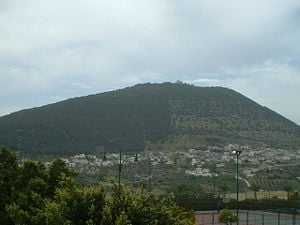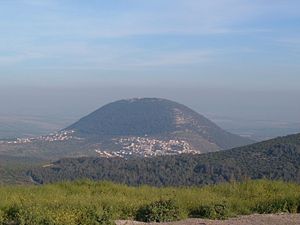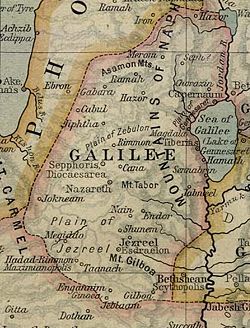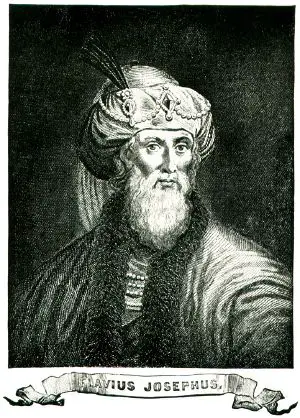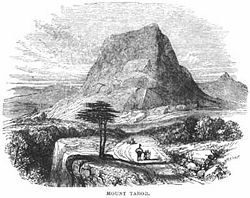Difference between revisions of "Mount Tabor" - New World Encyclopedia
m (→History) |
|||
| Line 17: | Line 17: | ||
According to the [[Book of Judges]], [[Deborah]] the prophetess summoned [[Barak]] of the tribe of Naphtali and gave him God's command, "Go and draw toward Mount Tabor, and take with you ten thousand men of the children of Naphtali and of the children of Zebulun" ([[Book of Judges|Judges]] (Judges 4:6). Barak agreed only on the condition that Deborah would accompany him, which they did, leading their troops to the mountain's high ground. Despite Sisera's superior strength, including 900 iron chariots, the use of Tabor's high ground gave the Israelites a decided tactical advantage. Descending from the mountain as Sisera's forces ascended, the [[Israelites]] attacked and vanquished their foes, and the heroine Jael soon killed the exhausted Sisera himself after luring him into her tent and lulling him to sleep. | According to the [[Book of Judges]], [[Deborah]] the prophetess summoned [[Barak]] of the tribe of Naphtali and gave him God's command, "Go and draw toward Mount Tabor, and take with you ten thousand men of the children of Naphtali and of the children of Zebulun" ([[Book of Judges|Judges]] (Judges 4:6). Barak agreed only on the condition that Deborah would accompany him, which they did, leading their troops to the mountain's high ground. Despite Sisera's superior strength, including 900 iron chariots, the use of Tabor's high ground gave the Israelites a decided tactical advantage. Descending from the mountain as Sisera's forces ascended, the [[Israelites]] attacked and vanquished their foes, and the heroine Jael soon killed the exhausted Sisera himself after luring him into her tent and lulling him to sleep. | ||
| − | Tabor was also the site of a battle between the Midianite kings Zebah and Zalmunna and certain Israelites, in which the Midianites prevailed but we later caught and executed by [[Gideon]] (Judges 8: 18-21) | + | Tabor was also the site of a battle between the Midianite kings Zebah and Zalmunna and certain Israelites, in which the Midianites prevailed but we later caught and executed by [[Gideon]] (Judges 8: 18-21) Some commentators, however, believe this "Tabor" should not be identified with the mountain but is more likely associated with Gideon's own territory of Ophrah in Benjamin. |
The "great tree of Tabor" was a well known landmark, possibly a sacred [[high place]], on the way for those traveling to the holy site of [[Bethel]], where the prophet Samuel instructed the future King Saul to meet three pilgrims and receive their gifts of bread and wine (1 Samuel 10:3). Psalm 89:12 mentions the mountain along with Mount Hermon in declaring is praise of God: "You created the north and the south; Tabor and Hermon sing for joy at your name." Jeremiah 46:18 likewise declares Tabor's outstanding character: "'As surely as I live,' declares the King, whose name is [[Yahweh|the Lord]] Almighty, 'one will come who is like Tabor among the mountains, like Carmel by the sea.'" | The "great tree of Tabor" was a well known landmark, possibly a sacred [[high place]], on the way for those traveling to the holy site of [[Bethel]], where the prophet Samuel instructed the future King Saul to meet three pilgrims and receive their gifts of bread and wine (1 Samuel 10:3). Psalm 89:12 mentions the mountain along with Mount Hermon in declaring is praise of God: "You created the north and the south; Tabor and Hermon sing for joy at your name." Jeremiah 46:18 likewise declares Tabor's outstanding character: "'As surely as I live,' declares the King, whose name is [[Yahweh|the Lord]] Almighty, 'one will come who is like Tabor among the mountains, like Carmel by the sea.'" | ||
| Line 23: | Line 23: | ||
[[Image:Ancient Galilee.jpg|thumb|250px|Map of the Galilee region c. 50 C.E. shows Mount Tabor directly below Cana and east of Nazareth]] | [[Image:Ancient Galilee.jpg|thumb|250px|Map of the Galilee region c. 50 C.E. shows Mount Tabor directly below Cana and east of Nazareth]] | ||
| − | After the establishment of the [[Temple of Jerusalem]], however, Tabor's high place shrine | + | After the establishment of the [[Temple of Jerusalem]], however, Tabor's high place shrine became a target for criticism by the [[prophet]]s and priests of Jerusalem, who considered it, and all unauthorized shrines, to be a source of corruption that prevented northern pilgrims from making their offerings properly at Jerusalem. The prophet Hosea thus declared: |
:Hear this, you priests! Pay attention, you Israelites! | :Hear this, you priests! Pay attention, you Israelites! | ||
Revision as of 16:56, 1 October 2008
Mount Tabor (Hebrew: הר תבור, Greek: Όρος Θαβώρ) is located in Lower Galilee at the eastern end of the Jezreel Valley, 17 kilometers (11 mi) west of the Sea of Galilee. Its elevation at its summit is 575 metres (1,843 ft) above sea level. In biblical history, is believed to be site of the battle between the Israelite general Barak and the army of Jabin, commanded by Sisera. Some believe it to be the site of the Transfiguration of Christ, although Mount Hermon is considered by many to be more likely.
Two Arab towns are located at its base: Shibli-Umm al-Ghanam (east) and Daburiyya (west) as well as a Jewish community called Kfar Tavor. It is also known as Har Tavor, Itabyrium, Jebel et-Tur, and the Mount of Transfiguration.
Geology and vegetation
The mountain is a horst—raised fault block bounded by normal faults formed from the extension of the Earth's crust—and is not volcanic. In spite of its proximity to the Nazareth mountains, it constitutes a separate geological form. Despite its modest height of 1,843 ft, it represents an impressive landmark, rising from a low-lying surrounding plain.
The mountain was entirely covered with typical Israeli vegetation until the reign of the Ottoman Turks, during which period most of the trees were felled. As part of the Jewish National Fund's efforts to recreate the landscapes of the country, the area was reforested with trees which are similar to its original vegetation. Today, most of Mount Tabor is covered with pine trees.
History
Its location on an important road junction and its commanding formation above its environment gave mount Tabor a strategic value, and several battles were conducted in its area in different periods in history. At the bottom of the mountain was an important roads junction: The Via Maris—the modern name for an ancient trade route, dating from the early Bronze Age, linking Egypt with the northern empires of Syria, Anatolia, and Mesopotamia—passed there from the Jezreel Valley northward towards Damascus.
Old Testament period
The mountain is first mentioned in Joshua 19:22, as border of three tribes: Zebulun, Issachar, and Naphtali. The mountain's importance stems from its strategic control of the junction of the Galilee's north-south route with the east-west highway of the Jezreel Valley.
According to the Book of Judges, Deborah the prophetess summoned Barak of the tribe of Naphtali and gave him God's command, "Go and draw toward Mount Tabor, and take with you ten thousand men of the children of Naphtali and of the children of Zebulun" (Judges (Judges 4:6). Barak agreed only on the condition that Deborah would accompany him, which they did, leading their troops to the mountain's high ground. Despite Sisera's superior strength, including 900 iron chariots, the use of Tabor's high ground gave the Israelites a decided tactical advantage. Descending from the mountain as Sisera's forces ascended, the Israelites attacked and vanquished their foes, and the heroine Jael soon killed the exhausted Sisera himself after luring him into her tent and lulling him to sleep.
Tabor was also the site of a battle between the Midianite kings Zebah and Zalmunna and certain Israelites, in which the Midianites prevailed but we later caught and executed by Gideon (Judges 8: 18-21) Some commentators, however, believe this "Tabor" should not be identified with the mountain but is more likely associated with Gideon's own territory of Ophrah in Benjamin.
The "great tree of Tabor" was a well known landmark, possibly a sacred high place, on the way for those traveling to the holy site of Bethel, where the prophet Samuel instructed the future King Saul to meet three pilgrims and receive their gifts of bread and wine (1 Samuel 10:3). Psalm 89:12 mentions the mountain along with Mount Hermon in declaring is praise of God: "You created the north and the south; Tabor and Hermon sing for joy at your name." Jeremiah 46:18 likewise declares Tabor's outstanding character: "'As surely as I live,' declares the King, whose name is the Lord Almighty, 'one will come who is like Tabor among the mountains, like Carmel by the sea.'"
After the establishment of the Temple of Jerusalem, however, Tabor's high place shrine became a target for criticism by the prophets and priests of Jerusalem, who considered it, and all unauthorized shrines, to be a source of corruption that prevented northern pilgrims from making their offerings properly at Jerusalem. The prophet Hosea thus declared:
- Hear this, you priests! Pay attention, you Israelites!
- Listen, O royal house! This judgment is against you:
- You have been a snare at Mizpah, a net spread out on Tabor. (Hosea 5:1)
The Second Temple period
In the days of Second Temple, Mount Tabor was one of the mountain peaks on which it was the custome to light beacons in order to inform the northern villages of holidays and of beginnings of new months.
Alexander Maccabeus of the Hasmonean house that led a rebellion against the Roman statesman Aulus Gabinius of Syria, was defeated at Mount Tabor with an army of 31,000 men from Judea. As many as 10,000 Jewish fighters were reportedly killed in the battle and Alexander himself was captured and executed.
In 66 C.E. during the First Jewish-Roman War, the Galilean Jews entrenched themselves at Mount Tabor under the command of Josephus Flavius, in order to defended against the Roman assault. Mount Tabor was one of 19 sites which the rebels in Galilee fortified, under the command of [[Josephus. According his account in The Wars of the Jews, the emperor Vespasian sent an army of 600 riders, under the command of Platsidus to fight the rebels at Tabor. Platsidus understood that he could not reach the top of the steep mountain with his forces, and therefore he summoned the Jews to negotiate. A group then descended from the mountain, but instead of parlaying with Platsidus, the they attacked his forces. The Romans initially retreated, but returned toward the mountain and attacked, killing many of the rebels and block the retreat for the remaining rebels whom tried to flee back up the mountain. Knowing they could not hold out many of the entrenched rebels left Mount Tabor and returned to Jerusalem. The rest, apparently including Josephus, surrendered after their water ran out, and they handed over the mountain to Platsidus.
After the defeat of the rebellion and destruction of the Second Temple in 70 C.E., Jewish settlement in and around Mount Tabor was renewed.
The Byzantine period and the middle ages
Mount Tabor became a focus of Christian pilgrimage which began during the fourth century, due to its proximity to Nazareth and the fact that Jesus is often described as retiring to a mountain to pray. Many believed it to be the site of the Transfiguration, although Mount Hermon is now thought to be a more likely candidate. According to descriptions of the pilgrims, during the sixth century, there were three churches on the top of the mountain, and during the eighth century there were four churches and a monastery.
During the period of the Crusades, the mountain changed hands many times between Muslims and Christians. In 1099 the crusaders fortified the area of the church and the monastery in order to protect pilgrims from the Muslims attacks. In 1212 the mountain was occupied by the Ayyubid Sultan Al-Adil I enlarged its fortress, but in 1229 it was occupied again by the Christians. In 1263 the Mamluk ruler Baibars occupied the fortress and ruined the Christian buildings on the mountain.
Place of Christian pilgrimage
The earliest identification of the Mount of Transfiguration as Tabor is by Origen in the third century. It is also mentioned by St. Cyril of Jerusalem and St. Jerome in the fourth century. It is later mentioned in the in the fifth century itinerary Transitus Beatae Mariae Virginis. According to Christian tradition, Jesus climbed to an unnamed "high mountain" with three disciples and was glorified before them while conversing with Moses and Elijah. The scene is described in the Synoptic Gospels, as well as alluded to in 2 Peter, but neither account identifies the "high mountain" of the scene by name. Contemporary scholars tend to identify Mount Hermon as a more likely site than Tabor, due to the fact that Jesus and his disciples are described as being in nearby Caesarea Phillippi shortly before their ascent to the Mount of Transfiguration.
Currently, on the mountaintop there are two Christian monasteries. In 1924, an impressive Roman Catholic church of the Franciscan order was built on the peak of Mount Tabor, Church of the Transfiguration. The church was built upon the ruins of a Byzantine church from the fifth or sixth century and a Crusader church from the twelfth century. The monastery's friars have lived near the church since the Ottoman control in 1873.
AGreek Orthodox church devoted to the Transfiguration of Christ, is located nearby. An All-Night Vigil is held there every year on the Orthodox Feast of the Transfiguration (August 19, which is August 6 according to the Julian Calendar).
Modern times
In 1799, during the time of Napoleon Bonaparte's expedition to the land of Israel, a French force of about 3,000 soldiers in the command of Napoleon and general Jean Baptiste Kléber fought against a Mamluk force of about 20,000 soldiers near Mount Tabor.
At the end of the nineteenth and the beginning the twentieth century the Bedouin tribe Arab-A Tzabiach settled in the mountain. Its members were employed by the neighboring Jewish settlements Kfar Tavor and Ilaniya, but disputed with them due to thefts. During the 1948 Arab–Israeli War members from the Arab-A Tzabiach tribe participated in theArab Liberation Army of Fawzi al-Qawuqji which killed seven members of the village Beit Keshet. In May 1948 the Israeli infantry's Golani Brigade occupied Mount Tabor and remaining members of the Arab-A Tzabiach tribe tribe fled to Syria and Jordan, except for the clan of Shibli, whose members collaborated with Israel. After they became Israeli citizens in the village Arab Al-Shibli, which is now part of the village Shibli-Umm al-Ghanam.
Tourism
Mount Tabor is located off of Highway 65, and its summit is accessible by personal vehicle via Shibli's access road. The peak itself is also traversed by the Israel National Trail.
Today reaching the top of the mountain itself does not demand great effort, but before roads were built a staircase of 4,340 stairs had to be climbed in order to arrive at the peak of the mountain.
There are two paths up the mountain: the long track, which starts from the Bedoiun village Shibli, which is about five kilometers long; and a short nature track of about two and a half kilometers to the summit. The Israel National Trail ascends the mountain from the Gazit junction and Shibli village, surrounds the summit, and descends across the Arab village of Daburiyya toward the Nazareth mountains.
Behind the monastery, remnants from the First Jewish–Roman War may be seen. On the paths there is a view of the Jezreel Valley, Mount Gilboa, the Samaria mountains, Mount Carmel, the Golan Heights, Gilead, the Lower Galilee, and the Upper Galilee. On clear days one can also see Mount Hermon.
Activities
- In April each year, the regional council of Lower Galilee holds a marathon race around Mount Tabor in memory of Yitzhak Sadeh, the first commander of the Palmach and one of the founders of the Israel Defense Forces at the time of the State of Israel's independence.
- Hunting of small animals is allowed in certain designated seasons after obtaining a game permit issued by the Ministry of the Interior,
- The churches located on the mountain allow visits at specific hours. (Modest attire required).
- The mountain serves as one of Israel's preferred locales for hang gliding.
Notes
ReferencesISBN links support NWE through referral fees
| |||||
Credits
New World Encyclopedia writers and editors rewrote and completed the Wikipedia article in accordance with New World Encyclopedia standards. This article abides by terms of the Creative Commons CC-by-sa 3.0 License (CC-by-sa), which may be used and disseminated with proper attribution. Credit is due under the terms of this license that can reference both the New World Encyclopedia contributors and the selfless volunteer contributors of the Wikimedia Foundation. To cite this article click here for a list of acceptable citing formats.The history of earlier contributions by wikipedians is accessible to researchers here:
The history of this article since it was imported to New World Encyclopedia:
Note: Some restrictions may apply to use of individual images which are separately licensed.
